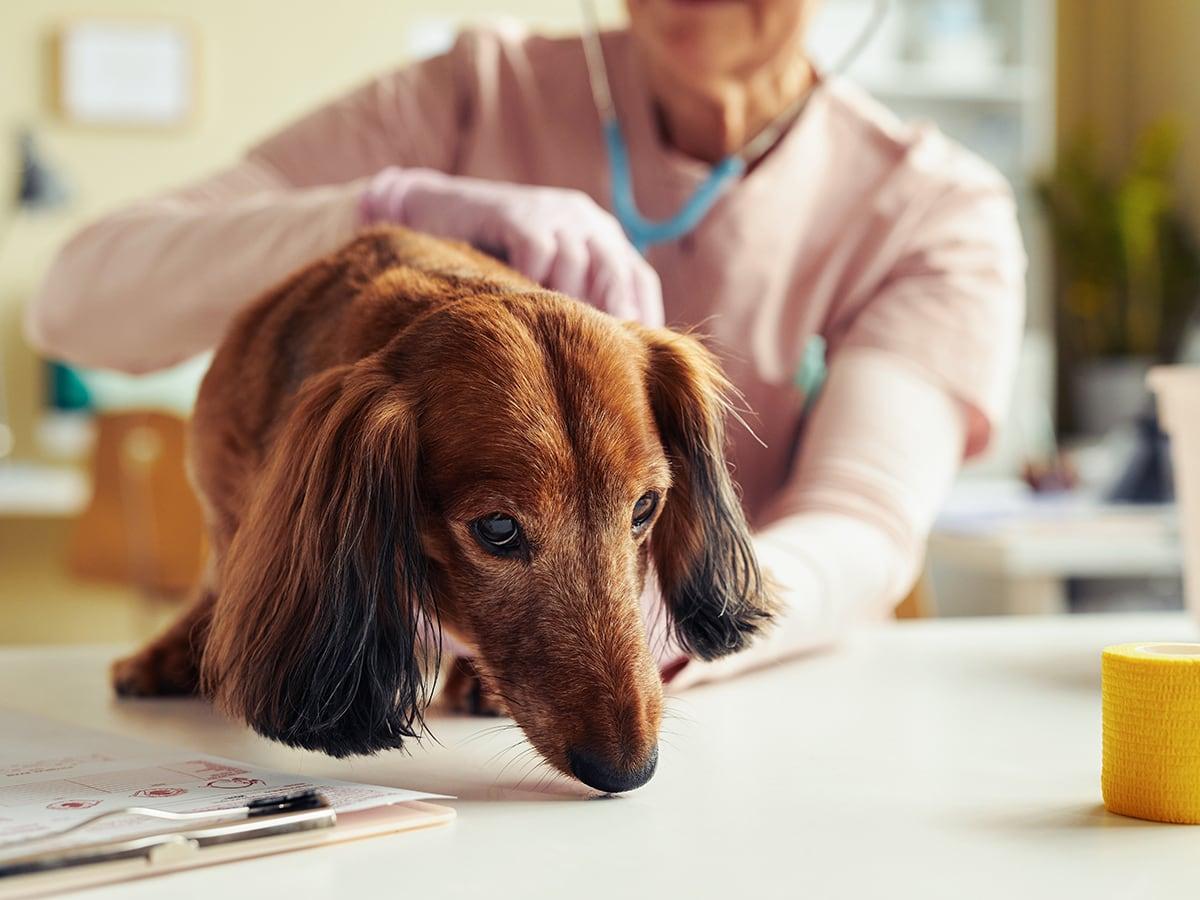Lipomas are one of the most common types of tumors diagnosed in dogs. While they can grow to a considerable size and may worry pet owners, these tumors are benign (non-cancerous) and rarely cause significant health problems.
This article will cover how lipomas in dogs can be recognized and diagnosed, and their potential treatment.
What are lipomas in dogs?
Lipomas, also known as ‘fatty lumps’ or ‘fatty tumors’, consist of an overgrowth of fat cells under the skin. These tumors become more common as dogs age, meaning they’re mainly seen in middle-aged and older dogs. Excess weight is also known to contribute to their development.
Lipomas can occur anywhere on the body, but they usually develop beneath the skin of the abdomen or chest. They normally grow quite slowly, over a period of several years, but small ones are easy to miss so they can seem to appear suddenly. Sometimes lipomas can grow more rapidly, over several weeks. While lipomas can remain small for many years, others will grow to a very large size.
Feeling or palpating a lump can help your veterinarian to determine whether it’s likely to be a lipoma. Most lipomas form in the loose connective tissue layer under the skin, where they can be felt as a smooth, soft lump. Simple lipomas should be able to move slightly relative to the overlying skin and underlying tissues.
Lipomas are also non-painful and shouldn’t cause any irritation or changes to the surface of the skin.
Infiltrative lipomas
Most lipomas are ‘simple lipomas’, as described above. These grow as discrete masses, only loosely connected to the surrounding tissues.
Infiltrative lipomas are less common. They are also benign but grow into neighboring muscle and other tissues, which makes them more likely to recur after surgery.
Note: a malignant version of the lipoma, called a liposarcoma, also exists. These tumors are infiltrative and can occasionally metastasize (spread) to other areas of the body. However, they are much less common than lipomas.
Read more: Lipoma Removal for Dogs: Price Guide
Diagnosing lipomas
Unfortunately, lipomas in dogs can’t be diagnosed reliably through palpation alone. For an accurate diagnosis, a sample must be assessed under the microscope to check that only fat cells are present and rule out other, potentially malignant tumors.
A definitive diagnosis can be obtained by:
Fine needle aspiration: a small needle (similar to the ones used for vaccinations) is used to take a tiny sample of cells. This can usually be performed conscious.
Biopsy: a larger sample of tissue is taken, usually under sedation.
Surgical removal: your veterinarian may recommend sending a suspected lipoma to a pathologist after surgical removal to confirm the diagnosis and check no further treatment is needed. Occasionally, a lipoma can develop over the top of a malignant tumor, so this approach ensures nothing is missed.
A fine needle aspirate is the least invasive option and can reliably diagnose lipomas and rule out other types of tumor. If the tumor feels less typical of a lipoma, or the fine needle aspirate is inconclusive, your veterinarian may recommend a biopsy.
Your veterinarian can tell you if a mass is likely to be a lipoma based on palpation. However, other growths such as cancerous mast cell tumors can look and feel very similar to a lipoma. These tumors can be life threatening, so further testing to definitively diagnose lipomas is always recommended.
Treating lipomas in dogs
If a lipoma has been definitively diagnosed, treatment is often unnecessary. Lipomas are benign and are typically more of a cosmetic issue than a health problem.
However, if a lipoma is growing rapidly or becoming particularly large, surgical removal may be recommended. Your veterinarian may also recommend removing lipomas on the thigh, in the axilla (armpit) and over the throat, as growths in these regions can affect mobility and cause discomfort.
Surgical removal of lipomas is typically a simple procedure, and most simple lipomas will not recur. Infiltrative lipomas are more likely to recur, but so-called ‘debulking’ surgery may still be helpful if they become large.
If a liposarcoma is identified, it should be surgically removed with wide margins. This tumor mainly affects older dogs and the prognosis after such surgery is good, with an average survival time of over three years.
Preventing lipomas
Unfortunately, there is no definitive way to prevent lipomas in dogs. However, dogs that are overweight are known to be at increased risk. Keeping your dog a healthy weight may lessen their risk of developing lipomas in addition to reducing their risk of more serious health conditions such as arthritis.
About the Author
This blog post was written by Dr. Primrose Moss, MRCVS, a practicing small animal veterinarian dedicated to making reliable veterinary knowledge accessible to all pet owners. Dr. Moss enjoys all aspects of her clinical work, but she also finds fulfillment in empowering pet owners with accurate information through her writing. You can learn more about Dr. Moss and her work by visiting her website at https://primrosemossfreelance.wordpress.com or connecting with her on LinkedIn.

Dr Primrose Moss, MRCVS, is a practising small animal veterinarian and writer. She enjoys all aspects of clinical work and aims to make accurate and reliable veterinary advice accessible to pet owners around the world through her writing. You can learn more about Dr. Primrose Moss here.
Brooks W. VETzInsight - Lipomas in Dogs and Cats. Veterinary Information Network. Published 2023. Accessed September 16, 2024. https://www.vin.com/vetzinsight/default.aspx?pid=756&catId=-1&id=5233990
O'Neill DG, Corah CH, Church DB, Brodbelt DC, Rutherford L. Lipoma in dogs under primary veterinary care in the UK: prevalence and breed associations. Canine Genet Epidemiol. 2018;5:9. Published 2018 Sep 27. doi:10.1186/s40575-018-0065-9
Animal Surgical Center of Michigan - Veterinarian in Flint, MI. www.animalsurgicalcenter.com. https://www.animalsurgicalcenter.com/fatty-tumors--lipomas
Baez JL, Hendrick MJ, Shofer FS, Goldkamp C, Sorenmo KU. Liposarcomas in dogs: 56 cases (1989-2000). J Am Vet Med Assoc. 2004;224(6):887-891. doi:10.2460/javma.2004.224.887











